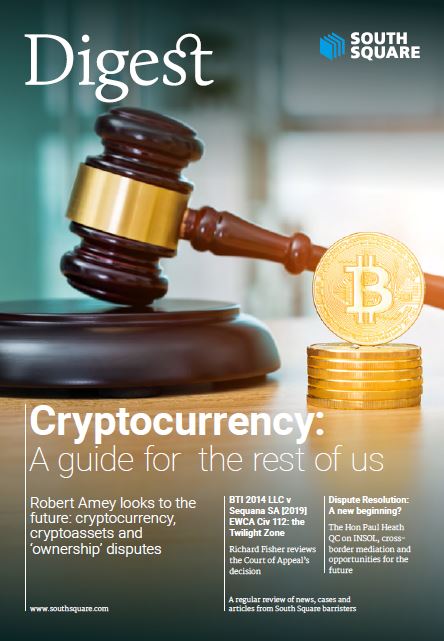
![BTI 2014 LLC v Sequana SA [2019] EWCA Civ 112: the Twilight Zone](https://southsquare.com/wp-content/uploads/2019/08/Capture_720x400_acf_cropped-1.jpg)
In February this year, the Court of Appeal dismissed an appeal and cross appeal against the decision of Mrs Justice Rose in BTI 2014 LLC v Sequana SA. In doing so, the Court of Appeal provided welcome guidance on the approach to directors’ duties in the twilight zone before insolvency, and the circumstances in which the payment of dividends might constitute a transaction susceptible to challenge under Section 423 of the Insolvency Act 1986.
As I observed in a previous Digest article relating to the first instance decision, the existence of longtail contingent liabilities is an unfortunately common feature of modern corporate groups. Actual and contingent asbestos liabilities drove the T&N group into insolvency. Other entities face liabilities for historical acts that they committed themselves, or as a consequence of successor liability, which, despite the purchase of insurance, continue to grow beyond anticipated levels and existing cover, and require ever more demanding provisions in their accounts.
Two principal issues came before the Court of Appeal in Sequana: (i) whether section 423 is capable of applying to the payment of dividends that are otherwise lawful (i.e. declared in accordance with the provisions of the Companies Act 2006); and (ii) when and in what circumstances does the duty of directors to have regard to the interests of creditors arise, and can it ever arise if the directors are considering the payment of an otherwise lawful dividend.
Those issues are very important in the existing business environment. If the current business is being conducted profitably, and the accounts demonstrate sufficient distributable profits, is it open to directors of a company to pay dividends to shareholders if they have made a reasonable estimate of the potential liabilities faced by the relevant entity? Or is something more required? Should prudence prevail, and the monies be retained in order to cater for the possibility that the contingencies will vest and liabilities exceed those estimates?
In Sequana, the issues arose in a scenario which can be simplified as follows. Company A faced potentially huge liabilities to indemnify a third party, B, for liabilities arising under the United States Comprehensive Environmental Response, Compensation and Liability Act 1980 (“CERCLA”). It had ceased to trade and had only these liabilities to deal with. Its assets consisted of a capped investment contract, certain historic insurance policies and an inter-company debt due to it from S. Based on matters of judgment by its directors, A’s accounts made a provision for these contingent liabilities in the amount of circa £50 million (which was considerably below the value of its assets).
The provision was at a level that enabled A’s directors to form the view that A was solvent, such that it was able to effect a reduction of capital and had sufficient distributable reserves in its accounts so as to enable it to declare dividends in two successive years to its parent company, S.
S, shortly after receipt of the second dividend, sold A on terms which sought to ensure that it could have no possible liability for any CERCLA indemnity. However, in due course, the creditors of A alleged that the provision in A’s accounts for the indemnity liability was manifestly inadequate.
What remedies, if any, are open to the creditors of Company A to challenge the payment of the dividends to S?
On appeal, there was no challenge to the Judge’s findings at first instance that the two dividends paid were lawful (in the sense of having been paid in accordance with the provisions of the Companies Act 2006). However, in relation to the second dividend paid, there was a challenge to the Judge’s conclusion that (i) the dividend was not paid in breach of duty; but (ii) did amount to a transaction falling within Section 423 (i.e. to defraud creditors). The appeal and cross-appeal were both dismissed. David Richards LJ has treated us to a comprehensive analysis of the principles in play in this area.
Section 423
Section 423 is a wide-ranging provision designed to protect actual and potential creditors where a debtor takes steps falling within the section for the purpose of putting assets beyond their reach or otherwise prejudicing their interests. The notion of transactions extends to gifts and transactions on terms that provide for the payee to receive no consideration (Section 436). The appellants challenged whether a payment of a dividend could amount to a “gift”, a “transaction” or “on terms that provide for the payee to receive no consideration”.
The Court accepted the submission of S that a dividend cannot amount to a gift because rights are conferred on shareholders regards dividends by the terms of issue of the shares or by the articles, and it is pursuant to those rights that shareholders receive dividends (at [41]). However, it rejected the argument based on the analysis of dividends in the tax case of Inland Revenue Commissioners v Laird Group plc [2003] 1 WLR 2476 that the transaction pursuant to which a dividend is paid is not the resolution of the directors or declaration of the dividend but rather the antecedent contracts between the company and its members (i.e. that in paying a dividend, the company is simply paying members what is already theirs as a matter of right, so that it is necessarily on terms that provide for the payee to receive no consideration). The correct analysis was said to focus on whether or not the company was parting with any property of funds beneficially owned by it in favour of its shareholders: if it was, and received nothing in return, the dividend was on terms that provide for the payee to receive no consideration in the required sense.
That was not, however, conclusive as to whether or a not a dividend amounted to a “transaction” in the required sense. Absent mutual dealing, or some form of active engagement between the company and recipient, could a dividend be a “transaction” The Court of Appeal concluded that it could. The definition of “transaction” was inclusive and not exhaustive, and although a transaction is normally used to denote some bilateral activity it can be used to denote an activity in which a single person is engaged i.e. a gift (at [58], applying obiter comments from Greenberg v IRC [1972] AC 106 at 136).There was no good policy reason for restricting the scope of Section 423 to exclude the payment of a dividend or any other unilateral act (albeit David Richards LJ also questioned at [61] whether a payment of a dividend really was a unilateral act in light of the pre-existing rights involved).
So far, so good and unsurprising. It would seem very strange if a decision to dividend out a large sum of money could not, in principle, be reviewed under Section 423 IA 86 albeit whether the required statutory purpose existed would be a question of fact in each case.
In this regard, the Court reiterated that the purpose of a person in entering into a transaction is a matter of the subjective intention of that person: what did he aim to achieve? Applying the test from IRC v Hashmi [2002] BCLC 489 at [23], it suffices if it “can properly be described as a purpose and not merely as a consequence, rather than something which was indeed positively intended”.
The line between something being “a purpose” even if not “positively intended”, but not a mere consequence, is rather difficult to draw, and in my view a rather unhelpful distinction. I am not convinced that the distinction is really anything more than whether a purpose (even if not the purpose, or the main or predominant purpose) of the person entering into the transaction was to put assets beyond the reason of a creditor or otherwise prejudice their interests. There must be some evidence of subjective purpose in this sense (rather than prejudice being a mere consequence of the transaction). Be that as it may, that is the test that we are to apply as a matter of fact in each case. The Court of Appeal concluded that there was no basis to disturb the judge’s finding of fact in this regard. What is clear, however, is that the application of the correct test is very sensitive to the correct identification of the transaction in issue and whether the transaction that deprives the company of value can be said to be one where there is evidence that the statutory purpose is satisfied. In many cases, particularly of complex transactions entered into with professional advice, that test will be very difficult to satisfy.
Finally, the Court reviewed the Judge’s approach to remedies. The Judge had concluded at [39] of her separate judgment that, where significant time had passed between the transaction and a successful challenge, and the relationships between the parties had changed, the Court was not limited to making an order that went no further than restoring the value of what was lost by the company at the time of the transaction (which the judgment of Sales J in 4Eng Ltd v Harper [2009] EWHC 2633 (Ch) at [9] had suggested). She concluded that if fairness to the victim required a wider order to be made, the Court could carefully tailor the relief granted to the facts so as to minimize the prejudice of what had occurred. The Court of Appeal upheld her decision in this regard, taking particular account of the fact that a subsequent settlement agreement had been necessary in no small part because the dividend had rendered A insolvent. Although the Court could not have a trial of the hypothetical issues of what had happened, it should strive to grant relief which, insofar as possible, restored the victim now to the position that it would have been likely to be in (see at [88]).
Directors’ Duties
The second, and perhaps most interesting, topic dealt with in the judgment is the approach to directors’ duties. We have long been aware that, as a company moves closer to insolvency, there is a point at which the interests of the members may have to give way to the interests of the creditors, being those with the principal economic stake in the business. The question is when, and whether any duty in that regard really extends beyond the statutory relief that may be granted where a director has engaged in wrongful, or even fraudulent, trading.
The argument of the creditor was that the directors owe a duty to consider the interests of creditors in any case where a there is a real, as opposed to remote, risk of insolvency. Such a duty was said to arise under Section 172(3) of the Companies Act 2006 and that, even where a dividend was technically lawful, could have been breached because of the company’s financial position.
The argument had an obvious superficial attraction: remember that A had ceased to carry on business. Its only function was to run off its indemnity liability and the dividend in question reduced its assets by some EUR 135 million. Even if the estimate of the provision needed for the contingent liability was made in accordance with the directors’ statutory duties and in compliance with the applicable accounting standards, it was clear (and common ground) that it might well be wrong (and probably would be wrong).
Much of what was recorded in the first instance judgment had been common ground, including that (i) the content of the duty does not vary according to the degree of risk of insolvency that has arisen, and (ii) that, if the court decides that the duty to take into account creditors’ interests has arisen but the directors did not in fact take the interests of creditors into account, that is not of itself a breach of fiduciary duty invalidating everything done automatically (applying Colin Gwyer v London Wharf (Limehouse) Ltd [202] EWHC 2748 (Ch)). If the directors could have reasonably concluded that the proposal in question should be approved even if creditors’ interest were taken into account, it may be that no breach occurs (see at [119]).
The key battleground was when the duty actually arose. The two alternative camps were, on the one hand, “a real as opposed to remote risk of insolvency” or, on the other, “insolvency, or very close to insolvency”.
Upholding the Judge, David Richards LJ confirmed that, as a matter of law, there were no English authorities which established the proposition that the creditors’ interests duty is triggered by anything short of actual insolvency, and that that was for good reason. Any other approach would hinder appropriate risk taking by directors and the economic benefits of conducting business through companies. Where Parliament had intended that there is a restriction on directors’ conduct where a company is anything other than insolvent or near to insolvency, it had done so through legislation (see at [202]-[213]). Having identified four potential points at which the creditors’ interests duty could arise (see at [213]), he concluded that the most appropriate formulation was that the creditors’ interests duty would arise when the directors know or should know that the company is or is likely to become insolvent (at [220]).
On this basis, the Court of Appeal accepted that, in theory, a decision to pay dividends might on the right facts amount to a breach of duty (see at [224]). However, there was no breach of duty on the facts of the case at hand, because A, the company, was not insolvent or likely to become insolvent at the point when the dividend was paid.
Interestingly, although left over for determination on another day, David Richards LJ indicated that, in his view, it was hard to see that creditors’ interest could be anything other than paramount once the directors knew or ought to have known that the company was presently and actually insolvent
(at [222]).
In so concluding, the Court of Appeal reminded us that, at their heart, companies are vehicles for risk taking (see [125] and [127]). It is for creditors to look after their own interests, albeit there has been some statutory intervention so as to ensure that certain transactions and conduct are regulated and potentially subject to review in any ensuing insolvency. Any recognition at common law of a duty to take into account the interests of creditors was very recent, as a masterful review of the authorities in this area demonstrated. David Richards LJ emphasized that a real, as opposed to a remote, risk of insolvency can arise even though the company is not insolvent and may very well never become insolvent, and that it is a much less demanding test than whether the company is likely to become insolvent.
The test promulgated by the Court of Appeal is getting close to the Section 214 threshold. Quite how likely it is that a breach of duty of the type considered will occur absent circumstances that will also amount to wrongful trading is difficult to predict, and something that is likely to be tested in further disputes in this area.
The Court of Appeal decision (and that of Rose J) provides a large degree of comfort to those advising directors that a commercial approach will be adopted. David Richards LJ’s reminder that companies are vehicles for risk taking, and that creditors cannot expect too much outside the statutory scheme, is good news. However, caution is required: there is an inherent conservatism that suggests to most practicing in this area that a dividend paid by a company that has ceased to trade, and faces large potential contingent claims, is inherently risky. The finding that Section 423 IA was applicable to the dividend payment notwithstanding that it was legal under Part 23 of the Companies Act 2006 may have surprised many. It will be necessary to test on the facts of a given case the true motivation for declaring a dividend. But Sequana is a lesson that, in the twilight zone, anything can happen.






![Brake & Anor v The Chedington Court Estate Ltd [2023] UKSC 29](https://southsquare.com/wp-content/uploads/2024/02/Brake-Anor-1-scaled.jpeg)










